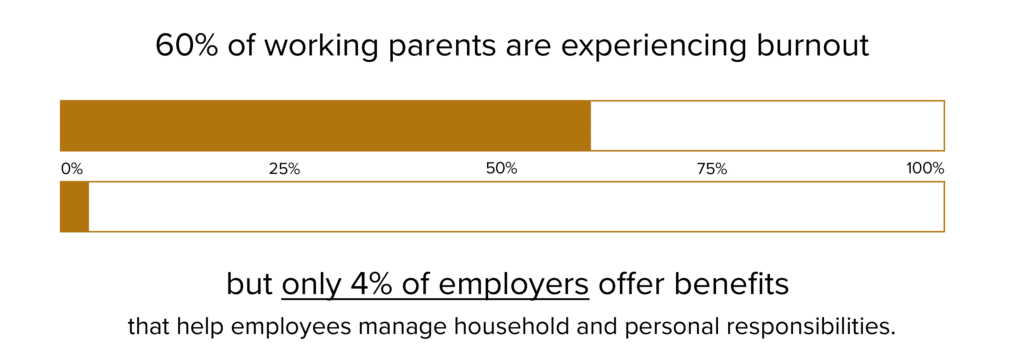
Parents are burned out and time bankrupt. How employers respond could make or break their companies’ post-COVID success.
We’re more than six months into the pandemic, and scrappy parents are still stitching resources together like they’re making a patchwork quilt. Some children are back to school in person, some are back in day care and some have private tutors or nannies, but overall, the pandemic continues to batter the child care and school systems that millions of parents rely on while they’re at work.
Parents are predictably burned out and this is more than just a family issue — it’s an issue for employers as well. It’s costing millions in turnover, absenteeism, presenteeism, low productivity and, once this is all said and done, recruiting expenses; the extent of which depends on what you’re doing right now. Case in point: a new survey by Prudential Insurance found that 52% of employees surveyed would leave their job for one with the “right” benefits.
But what are the right benefits?
In this article we’re covering the four most coveted time-saving benefits for working parents and how they’ll help you retain female talent. Plus, we share how to maximize the return on your benefit investments.
The New 401(k)
Parents are time bankrupt. Therefore, time has become a priceless commodity.
Not surprisingly then, parents are trying to save even more time, like it’s money. Employers can match these efforts, much like they match a 401(k), with benefits that give time back.
There are so many simple, cost-effective solutions, most of which can be outsourced, that it will only cost a small fraction of the time and effort spent on burnout, turnover and poor productivity.
Top 3 Time-Saving Solutions
1. Employer-sponsored concierge and errand running services
This benefit literally gives working parents time back by providing a resource for them to offload household chores, personal tasks, errand running and other responsibilities like oil changes, travel and event planning, and meal delivery.
On average the parents we serve save 1.2 hours per service.
Cost: Our clients have shared with us that a program staffed with one concierge often pays for itself if they retain just two employees.
2. Backup child care and elder care
85% of parents want child care benefits, according to an August survey by Care.com, but they’re rare. This leaves a huge opportunity for employers to distinguish themselves in the labor market.
According to the same survey:
- 60% of working parents say their job performance would improve if they had employer-sponsored child care benefits.
- 67% said they’d be more loyal to their company in return.
Cost: Services such as Care.com, an online marketplace that connects caregivers with families seeking care services, charge between $10-$15k for premium membership.
3. Virtual convenience services
Food services for business:
Dinner – the most daunting post-workday task. Support employees while they’re working from home or at the office with delicious meal options delivered anytime, anywhere and from any restaurant.
Cost: Meal delivery services start out as low as $5 a month per employee.
Laundry services:
Save parents time and money by having their laundry done for them. Some employers offer a stipend for home laundry services. Others, like JibJab, have their employees’ laundry picked up at headquarters and returned the next day.
Laundry perks give parents an additional two hours per week with the added benefits of lower water and electric bills.
Cost: The low-end average cost for laundry is $1.70 a pound. Order minimum is usually within the $30-$50 range.
Maximizing Your HR Investments
There’s strength in numbers. Layering benefit solutions for busy parents maximizes the returns on your investment by maximizing the benefits working parents reap.
Select benefits that solve for parents’ biggest time-sucks, such as child care emergencies, grocery shopping, errand running, laundry, car maintenance and other household chores. Saving two hours is always going to be better than saving one. Saving four, five or six is a dream come true.
Retain Working Moms
Between paid work, household responsibilities and child care, women work an extra month of 24-hour days each year compared with their husbands. As a result, women are leaving their jobs at an alarming rate.
Benefits that help working moms manage household and caretaking responsibilities can circumvent this. It’s how innovative organizations are attracting and retaining top female talent.
Around 75% of expecting mothers plan to return to work after maternity leave, but an overwhelming 43% resign shortly after returning.
With women comprising almost 50% of the U.S. labor force and a third with children under the age of 18, this comes at a considerable cost to organizations. Replacing an employee who leaves after childbirth can cost anywhere from 20% to 213% of their salary.
The greatest gift organizations can give working parents right now is time. Time to work without interruption, time for themselves, time to invest in their personal lives: their children, their partners and their aging parents.
The less stressed working parents are, the more employers will save in turnover, absenteeism, presenteeism, low productivity and recruiting expenses.
COVID-19 will pass but working parents’ memories of who helped when the chips were down won’t, making this a perfect time for employers to create a bond with their employees that will build loyalty and a high-performing culture.

